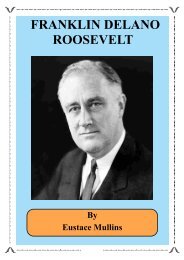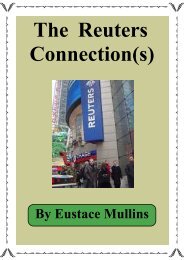Curse of Cannan - The New Ensign
Curse of Cannan - The New Ensign
Curse of Cannan - The New Ensign
Create successful ePaper yourself
Turn your PDF publications into a flip-book with our unique Google optimized e-Paper software.
Service. <strong>The</strong> propaganda was intended to be purely inflammatory, and no accusation was too<br />
wild to be denied a front page coverage in the American press. Alfred Ponsonby's book,<br />
"Falsehood in Wartime," E. P.<br />
Dutton, 1928, was one <strong>of</strong> a number <strong>of</strong> books which later exposed the fantastic lies which were<br />
used to incite Americans to go to war against Germany. Ponsonby's book was dedicated to his<br />
friends, the Marques <strong>of</strong> Tavistock and the 'historian Francis Neilson. On p. 17, Ponsonby writes,<br />
"General von Hutier <strong>of</strong> the 6th German army, '<strong>The</strong> method <strong>of</strong> Northcliffe at the Front is to<br />
distribute through airmen a constantly increasing number <strong>of</strong> leaflets and pamphlets; the letters<br />
<strong>of</strong> German prisoners are falsified in the most outrageous way, tracts and pamphlets are concocted<br />
to which the names <strong>of</strong> German poets, writers, and statemen are forged.' "On p. 19, "Tant que<br />
peuple seront armes, Ie uns contre les autres, lis aurent des hommes d'etatmenteurs, comme ils<br />
auront des canons et des mitrailleuses. As long as the peoples are armed against each other, there<br />
will be lying statesmen, just as there will be cannon and machine guns."<br />
One <strong>of</strong> the most notorious propaganda coups <strong>of</strong> World War I was the German "Corpse Factory,"<br />
the Kadaver. On April 16, 1917, the Time reported that "<strong>The</strong> Germans are distilling glycerine<br />
from the bodies <strong>of</strong> their dead, burning <strong>of</strong> bodies for fat, turned into lubricating oils, powder from<br />
bones; the story proved to be a popular one and was repeated for weeks afterward in the Times<br />
(London). On October 22, 1925, the Times belatedly blamed General Charteris for the story,<br />
which had proven to be the greatest propaganda falsehood <strong>of</strong> all time. Charteris, in a letter to the<br />
Times, November 4, 1925, denied any involvement with the story.<br />
Relying heavily on faked documents and doctored photographs, British agents deluged credulous<br />
American journalists with "hot copy." <strong>The</strong> result was that American mobs began to attack elderly<br />
German shopkeepers, blaming them for the "atrocities" committed in Europe. In most instances,<br />
these shopkeepers were the most staid, as well as the most patriotic, residents <strong>of</strong> their areas. <strong>The</strong><br />
principal vehicle used by Woodrow Wilson to justify his declaration <strong>of</strong> war against Germany<br />
was "submarine warfare" against American shipping; the keystone <strong>of</strong> this claim was the sinking<br />
<strong>of</strong> the Lusitania. In fact, the German government had published warnings to Americans in the<br />
<strong>New</strong> York press, advising them not to travel on the Lusitania, because it was known to be carrying<br />
munitions. George Sylvester Viereck showed this writer the actual clipping <strong>of</strong> this ad, which he<br />
had kept in his files. To this day, the United States government has refused to admit that the<br />
Lusitania was carrying arms, consigned to the British Army. In its issue <strong>of</strong> November, 1920, the<br />
Nation quoted D. F. Malone, Collector for the Port <strong>of</strong> <strong>New</strong> York as stating that the Lusitania<br />
carried 4200 cases <strong>of</strong> Springfield rifle cartridges on its manifest, consigned to the British<br />
government. <strong>The</strong> Wilson Administration had refused permission for Malone to publish this<br />
report. When Sen. LaFollette referred to it, they attempted to have him expelled from the Senate.<br />
Malone stated that he would testify in defense <strong>of</strong> LaFollette, and the attempt was dropped. Later<br />
records revealed that there were 5400 cases <strong>of</strong> ammunition on the Lusitania.<br />
<strong>The</strong> World War was satisfactorily concluded with some fifty million persons having been<br />
slaughtered, most <strong>of</strong> them prime representatives <strong>of</strong> the people <strong>of</strong> Shem. With this happy result,<br />
the Masonic Order <strong>of</strong> Canaanites decided to go for one hundred million victims in their next<br />
outing. For this purpose, they assembled the most sinister members <strong>of</strong> the world's Masonic lodges<br />
at the Versailles Peace Conference. As Ezra Pound later pointed out over Radio Rome, "<strong>The</strong> real<br />
crime is ending one war so as to make the next one inevitable." Woodrow Wilson became famous<br />
as the originator <strong>of</strong> the Fourteen Points and the League <strong>of</strong> Nations; in fact, he merely read from<br />
the script which had been prepared for him. <strong>The</strong> Fourteen Points and the other agenda <strong>of</strong> the<br />
Versailles Peace Conference had previously been drawn up at a secret meeting <strong>of</strong> the Grand<br />
Orient <strong>of</strong> France and the International Masonic Conference at their headquarters, 2 Rue Cadet,<br />
Paris, on June 28-30, 1917. <strong>The</strong> Versailles Peace Conference actually consisted <strong>of</strong> a three-tier<br />
system, each distinct from the others. <strong>The</strong> first was the public conference, highly visible, attended<br />
by swarms <strong>of</strong> reporters from all over the world, and extensively reported; the second tier was<br />
the secret conferences <strong>of</strong> the Big Four, who met privately to compare notes and go over their<br />
( Page 101)
















